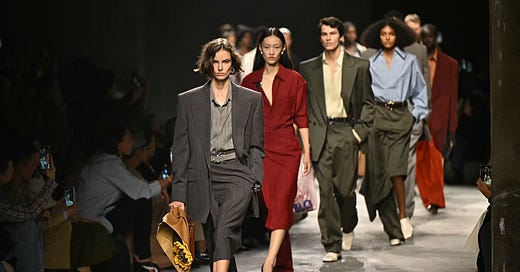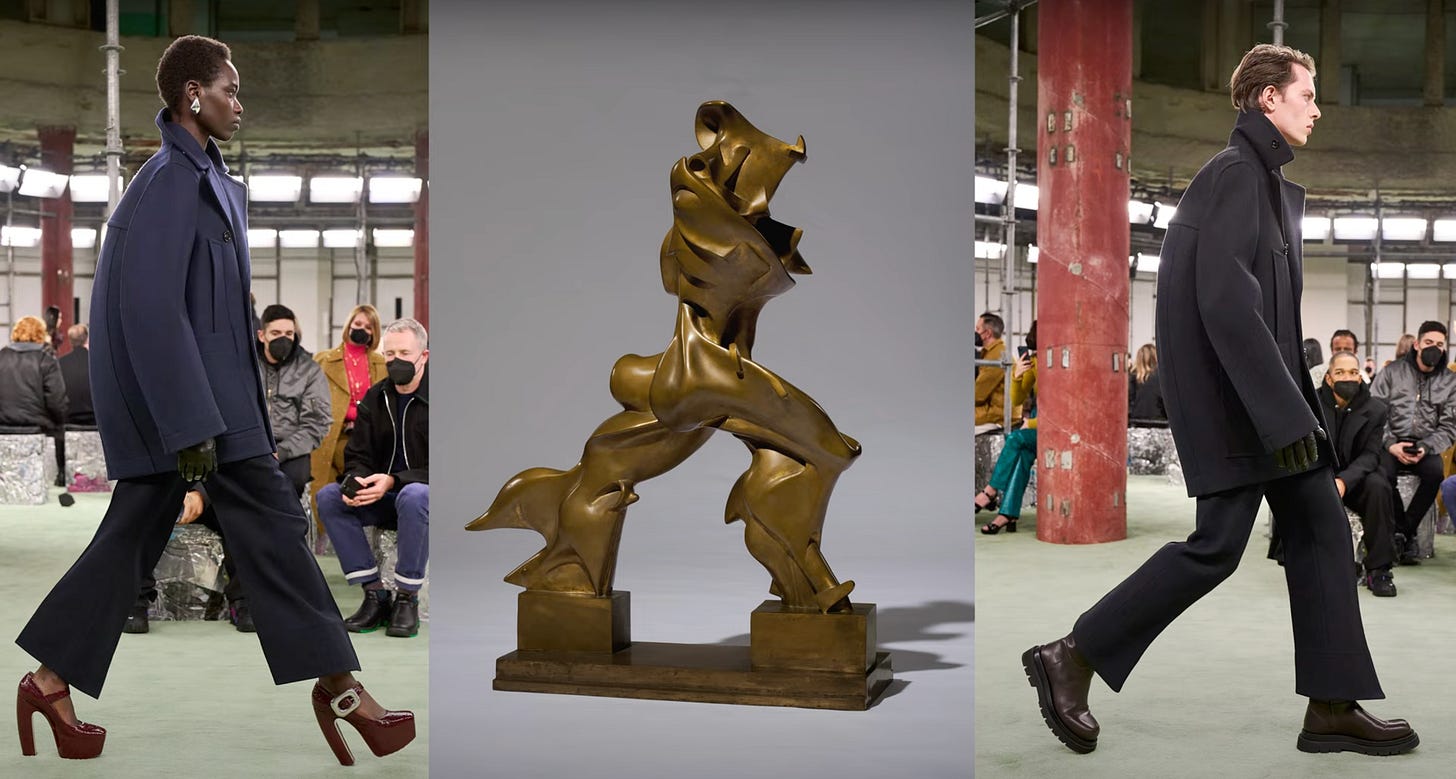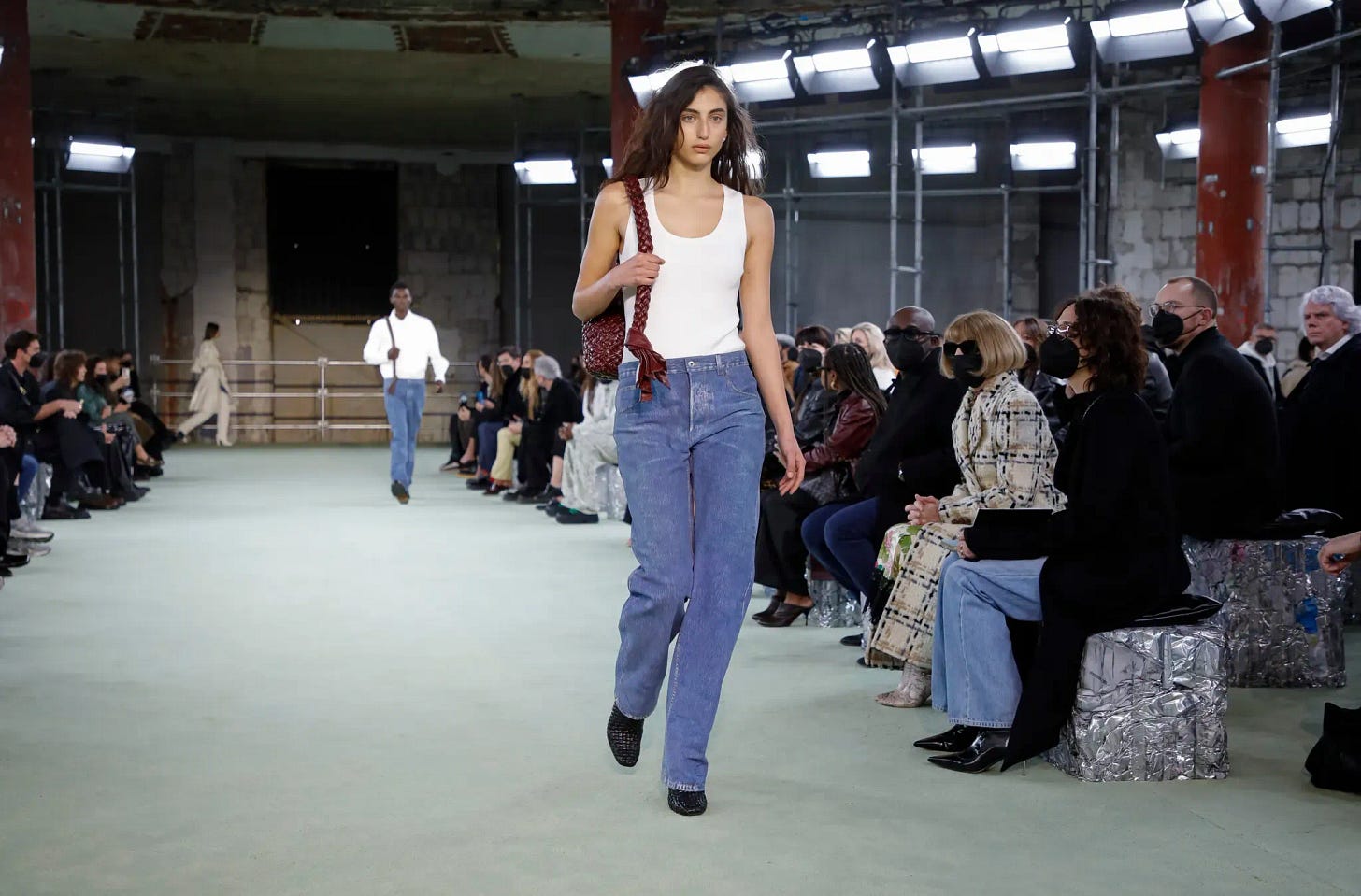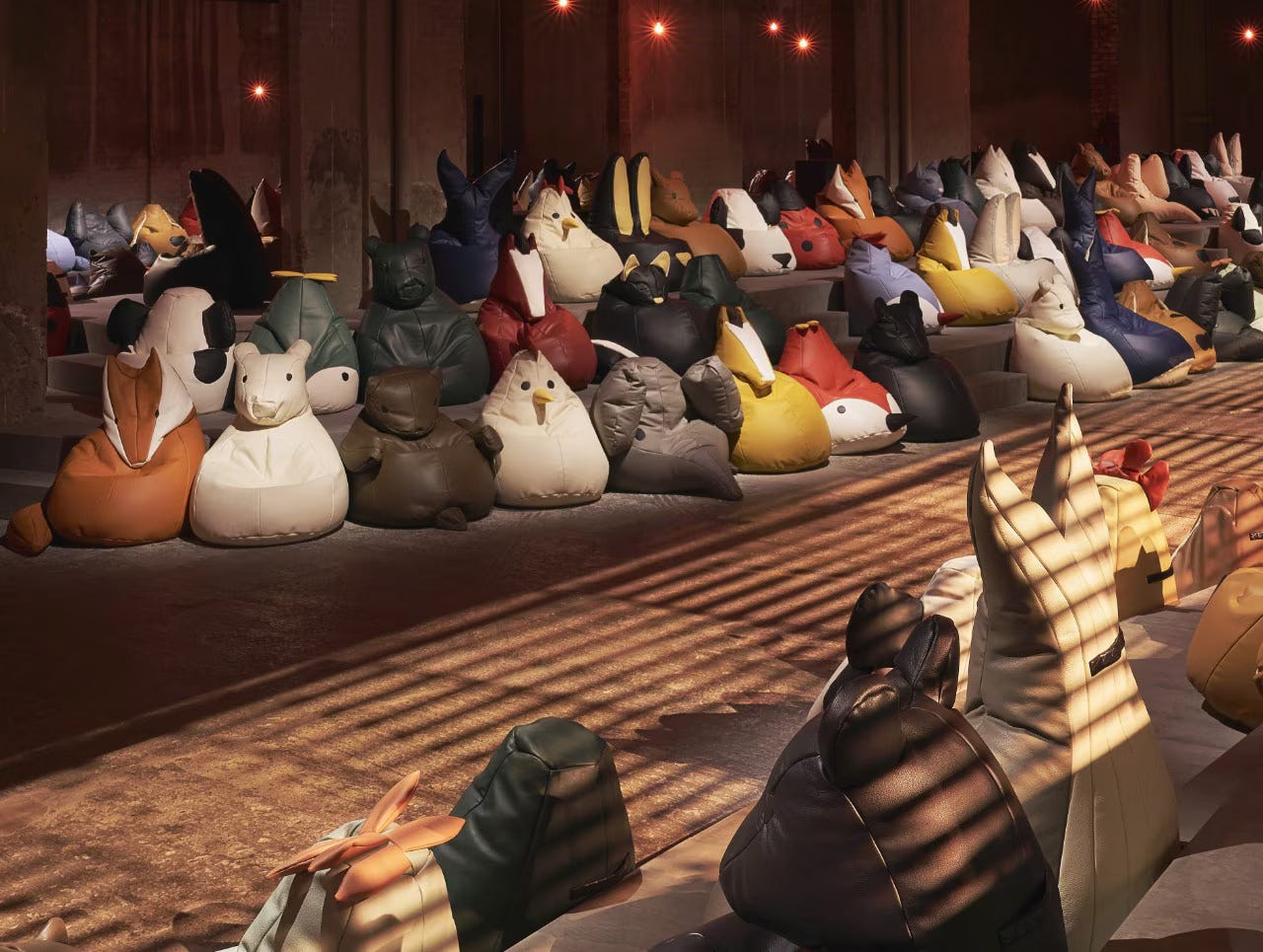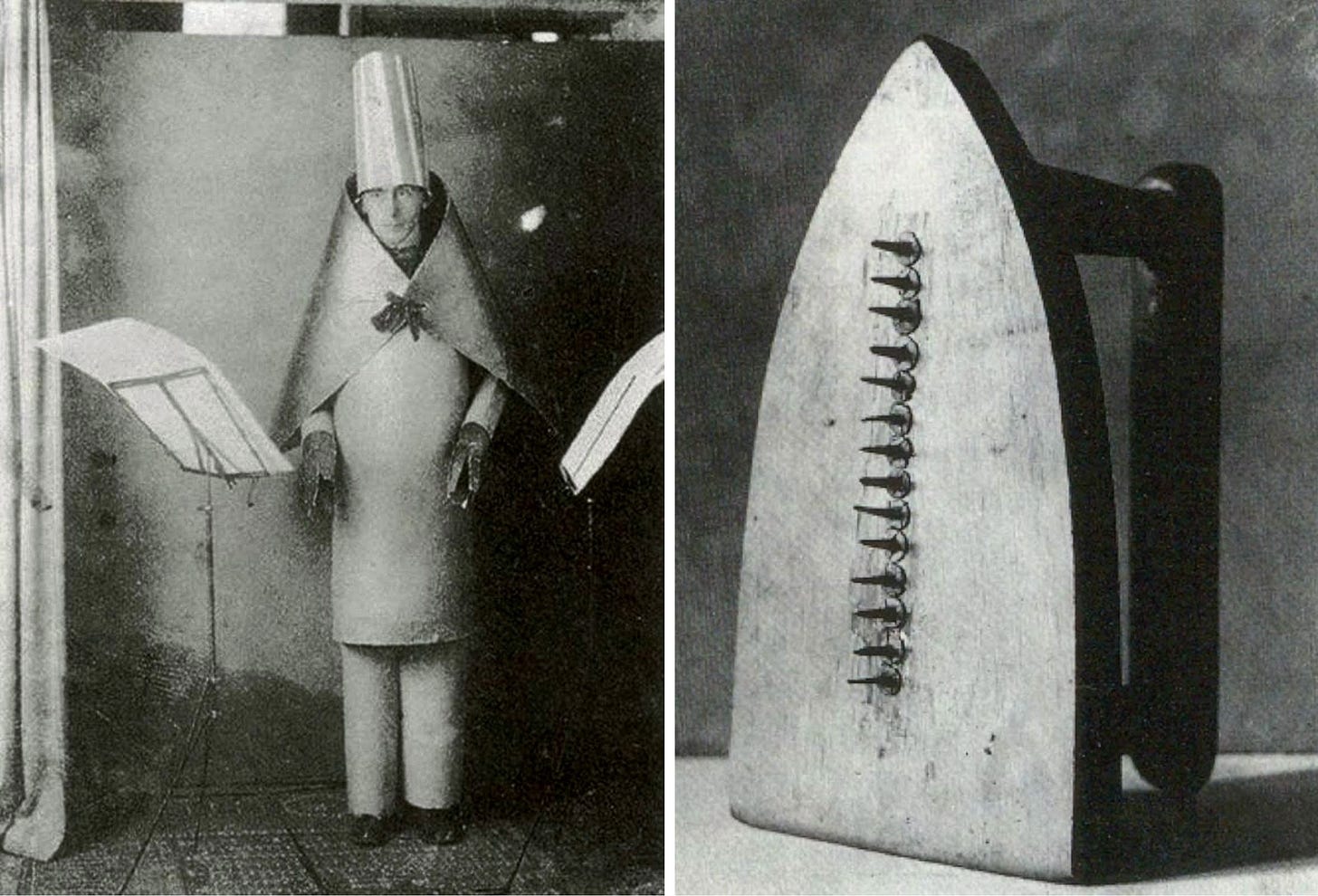Bottega and Bally, Milan’s leather-loving standouts.
The best bits from a very boring fashion week.
For this issue, I had plans to do a more macro look at how painfully boring most designers have become in this flop era for the fashion industry, but then two shows at Milan Fashion Week caught my attention: Bottega Veneta and Bally. An interest in Bottega isn’t much of a surprise given my love for its creative director, Matthieu Blazy, but the plot twist of being interested in Bally still has me shook. Let’s get into it.
Welcome to Public Service.
Bottega Veneta sells a dream (and other more expensive items).
I got distracted as the first model walked the runway for Bottega’s Spring 2025 show, like, “have to rewind to focus on the clothes” distracted. As the lights dimmed in the nondescript industrial space where the show was staged, a familiar sequence from Europa’s “6 A.M. Adolescence” began to play. “For most of us, when we get double messages, we get to pick one,” a young woman’s voice says before another older woman cuts in: “Okay, keep on walking down the street, and then my car is at the very end.” Quick cut back to the first woman: “The first of these messages is: I love you, go away.”
In February 2022, this same sequence of lines from this same track introduced the fashion world to Matthieu Blazy’s vision for Bottega Veneta. The full-circle moment is fitting, if unsurprising. Blazy has worked with the musician Le Motel and image and music director Pierre Debusschere since he took on the role of creative director following the abrupt departure of Daniel Lee. All eyes were on the then-35-year-old Belgian designer for his Fall 2022 debut, and he didn’t disappoint. Throughout that collection, he referenced Italian Futurist Umberto Boccioni’s distinct sculptural works through beautifully structured shell jackets and trousers. As fashion journalist Odunayo Ojo said of this collection: “There is fundamentally an idea of craft in motion.” And not to blow wind up Blazy’s ass, but it's been two and half years, and people still fawn over his first look: a seemingly ordinary-looking white tank top and jeans that were, incredibly, full-leather looks in masterful trompe l'oeil.
Five seasons later, as “6 A.M. Adolescence” once again filtered through the speakers, the first model on the runway traded in the jeans and tank top of that first season for a business suit. Blazy’s Bottega woman had grown up.. sort of. At first glance, the outfit looked sophisticated, adult, and fairly conservative — but then my eyes adjusted. Alongside her burgundy bag, the model clutched a knitted sunflower wrapped in brown papery leather. Her sharp-shouldered blazer slouched towards the ground. The trousers dramatically cut away on one leg — an asymmetrical, business casual, part-pants, part-skirt mashup.
As he explained to reporters after the show, who then regurgitated it into their runway recaps: “I was interested in the idea of wow, the wonder you have as a kid when you try something — it’s almost like primal fashion, your first experience of fashion when you try your parents’ clothes.” Cue the oversized (yet still chic) proportions and a fair bit of fun (as much as he could squeeze out while still being palatable). Alongside the heavy dose of childlike wonder, the animal beanbag chairs — stitched in leather (of course) and designed by Zanotta Sacco — nodded to a more extraterrestrial level of influence. Specifically, the chairs were ripped from that scene in E.T. when the titular alien hides amongst the stuffed toys. Celebrities lounged in animal chairs that were handpicked for them (Kendall Jenner on a horse, Michelle Yeoh on a ladybug etc.). On the runway, animals were sprinkled through with restraint. A bunny print here, a frog brooch or fish earring there.
It’s easy to mock a brand as eye-wateringly expensive as Bottega Veneta for selling oversized clothes with detailing inspired by a film that probably had a lower budget than it would cost to buy the entire collection. I get it. Fashion is a business, first and foremost, and a wasteful one at that. Fashion is a hamster wheel of endless collections and overpriced clothes, and the hamster wheel is also on fire. But fashion is also art and its storytelling. Watching Blazy’s Bottega show, I felt moved by the core message that we’re all just kids, playing around in oversized clothing, growing into adulthood. Things get wrinkled and scrunched up. Our lives go into odd angles and don’t take on the texture we expect. And sometimes, like Le Motel’s Spring 2025 soundscape, a ghostly rendition of “Mmmbop” by Hanson floats into our brains and refuses to leave — or a brief segment from “Elegy for Dunkirk” by the English Chamber Orchestra reminds us of that time we heard it in Atonement. Sorry, what was I saying?
With this new Bottega collection, Blazy reaffirmed his status as one of the fashion industry’s most skilled and thoughtful creative directors. Will I ever afford to buy anything from the brand? Highly unlikely, given that I’ve aged out of the “sugar baby” window years ago and decided to become a freelance writer. I may not be lining up to buy his beautiful bags, but Blazy sold something that even my meager life savings can afford to try on for size: a dream of adulthood that’s not so damn serious all the time.
Show Notes:
If you’re wondering about the sequence of songs in Le Motel’s mix for this collection, you’re in luck. My unhinged ass pulled up Shazam throughout the livestream and got to work.
“6 A.M. Adolescence” by Europa
“When We’re Older” by James Blake
“Mmmbop” by Hanson
“Elegy for Dunkirk” by the English Chamber Orchestra
“Put on Your Sunday Clothes” by Michael Crawford & Barbra Streisand (yes, the one from Hello, Dolly)
“The Forest is Full of Riches” by Tom Niland
“Pilot” by COEN
“Piano Sonata No.14 in C sharp minor, Op.27 No.2” by Claudio Arrau
A surprisingly good Bally show goes Dada for cowbells.
If someone had told me a week ago I’d be writing about Bally, the Swiss brand that releases travel collections “designed by Adrien Brody,” I’d assume a kidnapping and ransom note was involved. Sorry to Bally, but the luxury design house hasn’t exactly been pinging my radar. I probably wouldn’t have even checked out the show if it hadn’t been for a Milan recap on the fashion podcast The Run-Through with Vogue; Nicole Phelps, Vogue Runway’s director, and Tiziana Cardini, a Milanese fashion contributor, both sang the praises of Simone Bellotti, the brand’s new(ish) creative director and picked Bally’s Spring 2025 show as a highlight.
I immediately understood the Bellotti buzz as I pressed play on the show. From the very first second, the show makes an impact: a model enters the sunny open courtyard as a synth-heavy, techno-thriller soundscape by Swiss musician Aisha Devi begins to play. The sunny staging and dark music offer a stark contrast to kick off the show, but the messaging shifts as more and more looks are unveiled. The collection isn’t focused on dystopia. It’s focused on Dada. Just like the famed anti-establishment art movement that began in 1915, the Bally collection also seems to be reacting to the horrors of war (one thing that seems to always remain constant in human history). Artists reacted to the First World War through irrationality and absurdity; Bellotti used Dadaism similarly, transferring the movement’s themes into meditations on form. As Cardini notes in her show review:
Bellotti’s moodboard featured an eclectic mix of imagery, but one portrait stood out, that of Hugo Ball, the sound-poetry author and founder of the Dada movement in 1916 Zürich. Surrounding Ball’s image were photos of rustic, oddly-shaped cowbells, rusted shoehorns, and Man Ray’s artwork The Gift — a flat iron with thumbtacks glued along its sole. What captivated Bellotti about Ball’s portrait was the striking costume: a tall cylindrical hat and a metallic cone-shaped cape, with a stiff high collar framing his face.
Odes to Man Ray’s piece The Gift could be spotted in spiky shoes and studded bags, while a series of skirts shaped like cowbells were occasionally lifted in the front like a freeze-frame of Marilyn Monroe standing over a subway grate. The central obsession with Ball translated into mountainous, sloping silhouettes that framed the models’ faces, with one standout coat looking like a luxurious, leathery rendering of Ball’s ludicrous performance outfit. Seeing Bellotti's vision for this season reminded me of the joy I felt wandering around the Venice Biennale in 2022 compared to the blandness of this year’s Biennale; the 2022 edition leaned into absurdity through the embrace of Surrealist artist Leonora Carrington, and the 2024 edition tied itself to identity politics through its steadfast embrace of “the foreigner.”
The divergent emotions I felt from these past two Biennales overlap with how I’m feeling about fashion. Some designers still seem capable of embracing absurdity and creativity, but as the luxury fashion market continues to slow down, the rise of “safe” collections that look ready to go straight from the runway to the outlet sale seems to be the style du jour. Before I close out my recap, I want to take note of one final detail. The collection’s title, “counterpoint 3,” nods to the musical technique of playing melodies in concurrence with one another — designating a clear throughline between Bellotti’s first two seasons and this new chapter. After watching his Spring 2025 show, I watched runway videos and read recaps of his first two collections. While I can’t say I was moved by them, it’s clear that season by season, Bellotti is beginning to create a melody that’s worth singing.
A lot has changed, but here’s what will always be constant: if you liked what you read, please consider forwarding this to your friends; more readers means more contributors, which means more interesting content.
Thanks for joining me and have a nice day!

